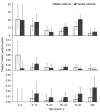Diphtheria in the postepidemic period, Europe, 2000-2009
- PMID: 22304732
- PMCID: PMC3310452
- DOI: 10.3201/eid1802.110987
Diphtheria in the postepidemic period, Europe, 2000-2009
Abstract
Diphtheria incidence has decreased in Europe since its resurgence in the 1990s, but circulation continues in some countries in eastern Europe, and sporadic cases have been reported elsewhere. Surveillance data from Diphtheria Surveillance Network countries and the World Health Organization European Region for 2000-2009 were analyzed. Latvia reported the highest annual incidence in Europe each year, but the Russian Federation and Ukraine accounted for 83% of all cases. Over the past 10 years, diphtheria incidence has decreased by >95% across the region. Although most deaths occurred in disease-endemic countries, case-fatality rates were highest in countries to which diphtheria is not endemic, where unfamiliarity can lead to delays in diagnosis and treatment. In western Europe, toxigenic Corynebacterium ulcerans has increasingly been identified as the etiologic agent. Reduction in diphtheria incidence over the past 10 years is encouraging, but maintaining high vaccination coverage is essential to prevent indigenous C. ulcerans and reemergence of C. diphtheriae.
Figures



References
-
- Begg N. Diphtheria: manual for the management and control of diphtheria in the European region. Copenhagen: Expanded Programme on Immunization in the European Region of WHO; 1994.
MeSH terms
LinkOut - more resources
Full Text Sources
Medical
Miscellaneous
